The island Guernsey, one of the English Channel Islands, is known for its clematis production. That’s due in large part to the enthusiasm of breeder Raymond Evison. Over 2 million young plants a year are being produced at his 4.5 acre company Guernsey Clematis Nursery, which provides 20% of the world's annual requirements of young clematis plants. The biggest market is the USA, Canada, Japan, South Korea, China, the United Kingdom, Ireland and Europe. After years of breeding in cooperation with Poulsen Roses, Raymond is introducing a new breeding program under his own company name Raymond J. Evison Ltd.
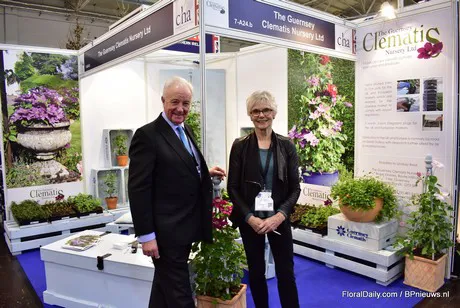 Raymond Evison and Lindsay Reid of The Cuernsey Clematis Nursery at the IPM Essen 2019.
Raymond Evison and Lindsay Reid of The Cuernsey Clematis Nursery at the IPM Essen 2019.
Moving production from UK to Guernsey
“I started in plants and gardening in England when I was 15 years old. By 23 I was managing director at the business that my father had started where we were specializing in the production of young clematis plants. We got the production up to 250,000 plants a year. During the winter of 1981 temperatures in the central part of England, where our company was located, dropped to -26 Celsius. We lost a third of our plant material in our nursery and our gardens were devastated. It was a tough time and then I decided that I wanted production of clematis in a milder climate. So in 1984 I set up a clematis nursery in Guernsey. First we focused on the UK market, two years later we exported to Germany. And when a drought hit the UK in 1989, we started to sell to North America too. Our business has been growing ever since.”
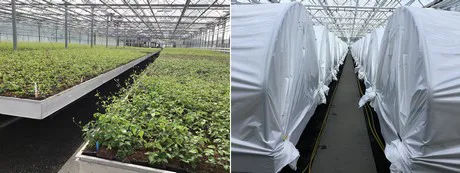
Clematis in the greenhouse at Guernsey Clematis Nursery
Breeding compact clematis
Over 75 percent of the plants Raymond Evison Clematis sells are hybrids that are the result of the Evison-Poulsen breeding program, which ran from 1995 to 2008. The breeding program focused on the needs of the end consumer, bringing compact plants that would flower on the shelves and for a longer period in the garden and that could be pruned and maintained easier. "From those years, we put 100 patented cultivars on the market."
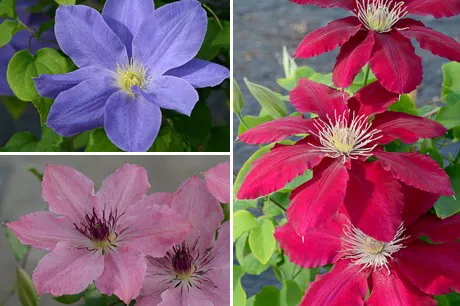 Clockwise; Diana's Delight (“one of our successful hybrids"), Rebecca ("our best selling clematis ") and Sarah Elizabeth our 2018 introduction
Clockwise; Diana's Delight (“one of our successful hybrids"), Rebecca ("our best selling clematis ") and Sarah Elizabeth our 2018 introduction
Own branding
After the fruitful cooperation with Poulsen, Evison started his own breeding program; the Evison breeding program. “I didn’t start the brand just for my ego or my bank account”, he explains with a laugh. “We started the brand 15 years ago when we had very wet springs three years in a row making the garden center sales very dreadful. Our growers in England were producing good plants, but once put in the garden centers the clematis waiting for sale grew two centimeters a day and got entangled, which made selling them even harder. So with two English growers we started to look at a range of Evison Poulsen clematis selected the best and most compact varieties and made them Raymond Evison branded clematis. We used my signature as the brand logo.”
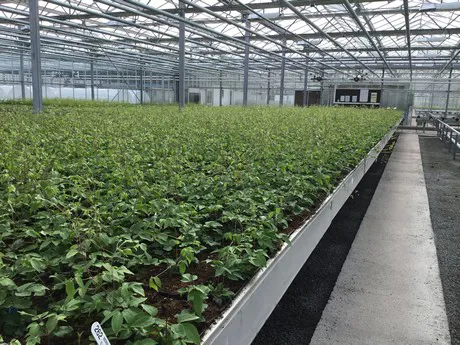
Trials
After the cooperation with Poulsen Rosen, Evison continued breeding and 2019 will be a year full of trials. “The first selections were produced in 2016-2017 and in 2018 we flowered 2000 new hybrids. Then we kept 180 of those plants and bulked up for extra testing and coming April we have 2,500 more seedlings waiting to be tested. We especially are looking to produce better clematis in red and blue colours and also double forms. After all this testing we will only put only the very best on the market. I expect the first varieties to put on the market in 2 or 3 years’ time.”
How demand developed
Raymond noticed that brands sell really well in the North American market and calls David Austin as a example. “We are many years behind of what they are doing. The popularity of clematis has gone up and down in the last decades. Now, demand is increasing and we do all publicity that we can to promote it to the end consumer and through Raymond Evison Clematis, I wrote and published books on how easy it is to grow and maintain clematis in the garden. I certainly see professional growers to whom the clematis is a new crop starting to grow this plant all over the world, for example South Korea where they see them more as a flowering pot plant than as a garden plant. People in Chile are also very interested in clematis and new customers start growing them in North America. I am happy to see that clematis is becoming a plant people want to grow.”
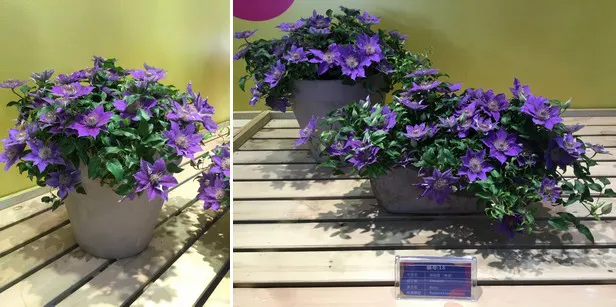 Bijou. "This variety is doing very well in China and even won an award."
Bijou. "This variety is doing very well in China and even won an award."
Excited about the future
When asking him about the future Raymond is probably even more enthusiastic as he is when he is talking about the past. Although he is 75 years old, his greatest love is to get his boots on and go climb mountains in China to find plants and clematis species. “I would love to bring scented varieties to the market. While breeding I do my best keeping pace what the UK market requires and keep an eye on the EU market. And also the Chinese market where they have cold winters and hot summers. Every market asks for a different type of clematis. Also in the US we have to take into account the temperatures, in zone 4 to 9 our clematis are cold hardy, in other zones we need to breed hybrids that are more winter hardy.” Then there are all kinds of shapes and colors to keep the breeder busy. According to Raymond there is a market for dwarf clematis like Filigree and the Bijou which won an award in China. “Consumers all around the world would like to have a pretty garden but they don’t have the time and the space to grow large plants, so compactness is very important in these days.”
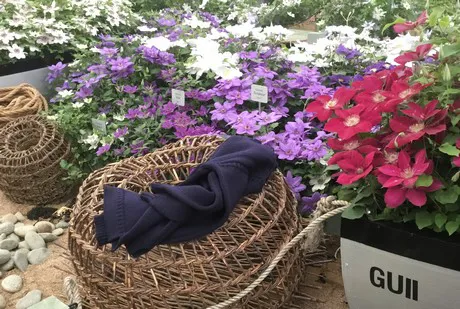 Display at Chelsea Flower Show 2018.
Display at Chelsea Flower Show 2018.
Chelsea Flower Show
As Evison is so eager to let the end consumer learn and show the clematis, he is showcasing his plants at the Chelsea Flower Show for many years now. And to date, he has been awarded 29 Chelsea Flower Show Gold medals (including 15 consecutive Chelsea Gold Medals) as well as many other annual RHS awards for outstanding exhibits of clematis plants. This year, he hopes to see the 30th Chelsea Flower Show Gold medal being awarded. This year the exhibit will feature 2,000 plants of at least 29 clematis varieties. Special this year is the launch of a new clematis variety; Vicki, named after Evison's great friend from Guernsey, Mrs Vicki Smith.
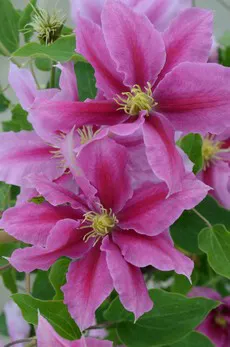 Vicki's career as florist and flower arranger took off in 1960 when she qualified at Constance Spry in 1960 and worked on their Chelsea Flower Show exhibit that year. As part of a team, she also arranged the wedding flowers of HRH princess Margaret and the celebrated "Ballroom of Flowers" for the American Ambassador. Afterwards, she became the NAFAS youngest Demonstrator and Judge. Over the next 50+ years, she has decorated everything from Village Halls to Royal Palaces. Now, she is retired and still in love with flowers and arrangement; she creates displays for her own home on the island of Guernsey.
Vicki's career as florist and flower arranger took off in 1960 when she qualified at Constance Spry in 1960 and worked on their Chelsea Flower Show exhibit that year. As part of a team, she also arranged the wedding flowers of HRH princess Margaret and the celebrated "Ballroom of Flowers" for the American Ambassador. Afterwards, she became the NAFAS youngest Demonstrator and Judge. Over the next 50+ years, she has decorated everything from Village Halls to Royal Palaces. Now, she is retired and still in love with flowers and arrangement; she creates displays for her own home on the island of Guernsey.
For more information
Raymond Evision Clematis
Raymond Evison
Email: [email protected]
www.guernsey-clematis.com
Guernsey Clematis Nurseries
www.guernsey-clematis.com
